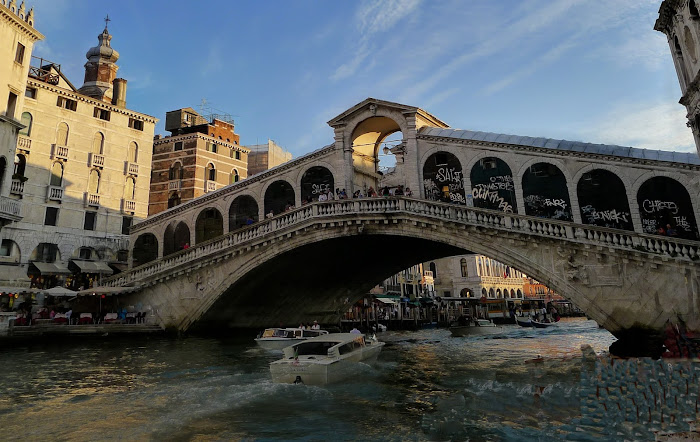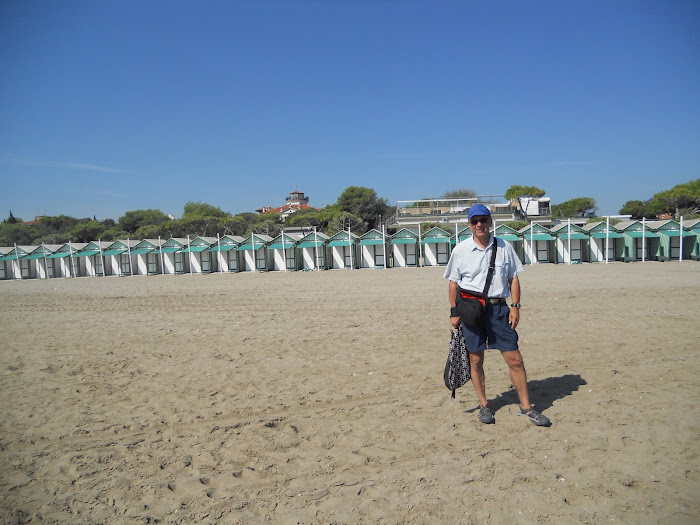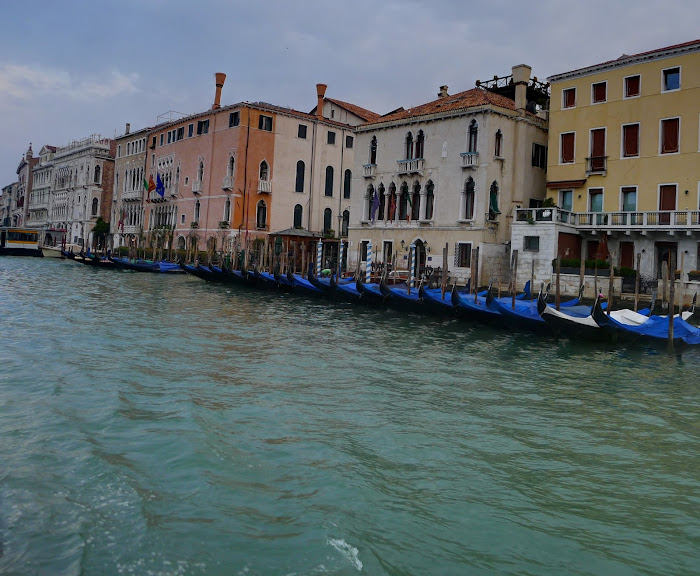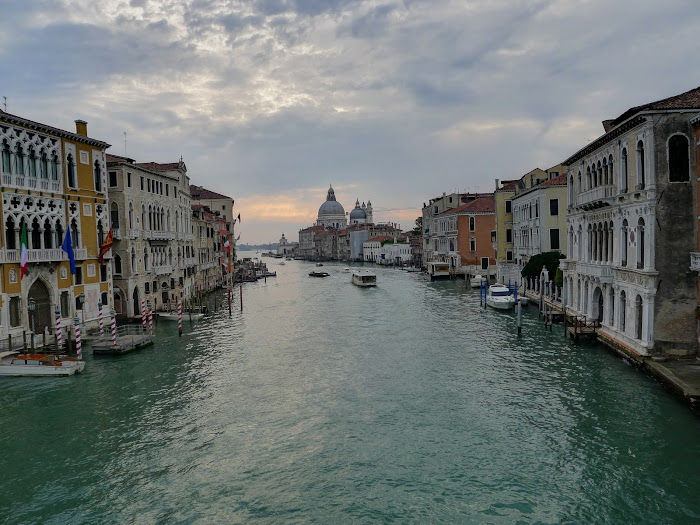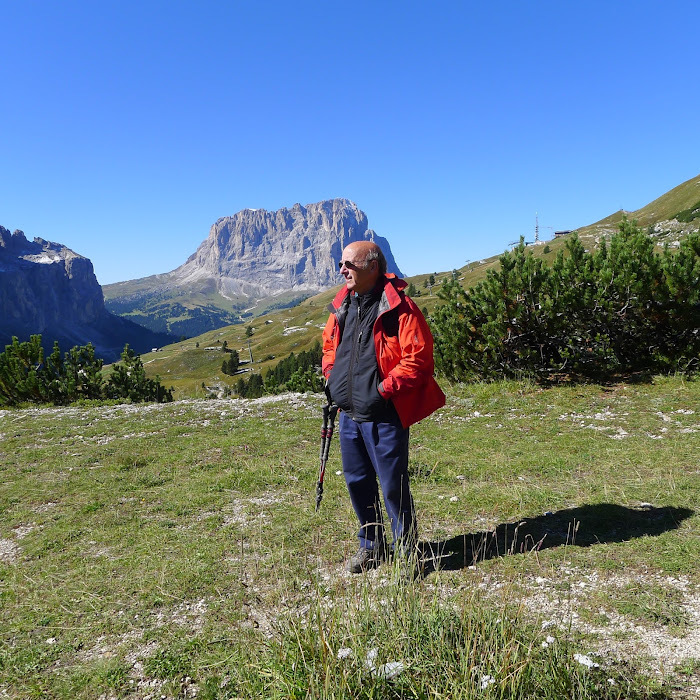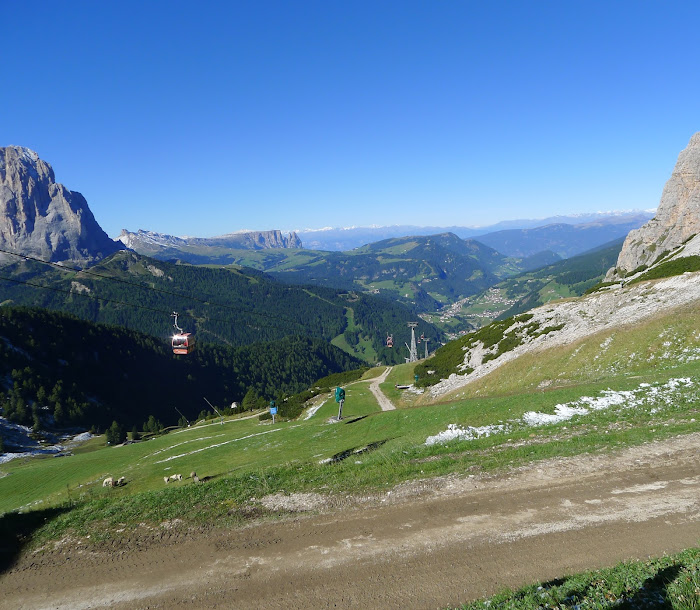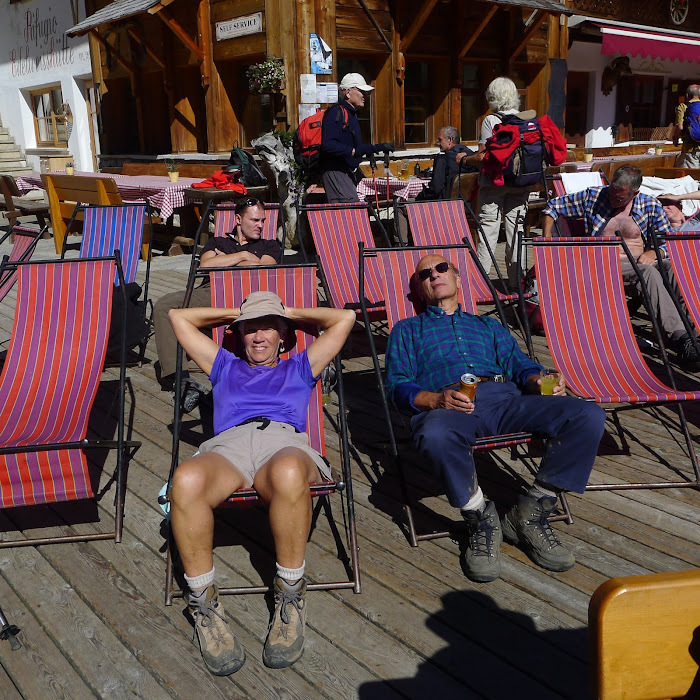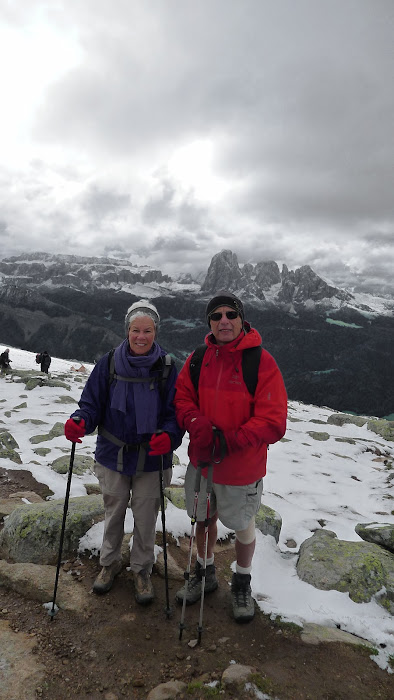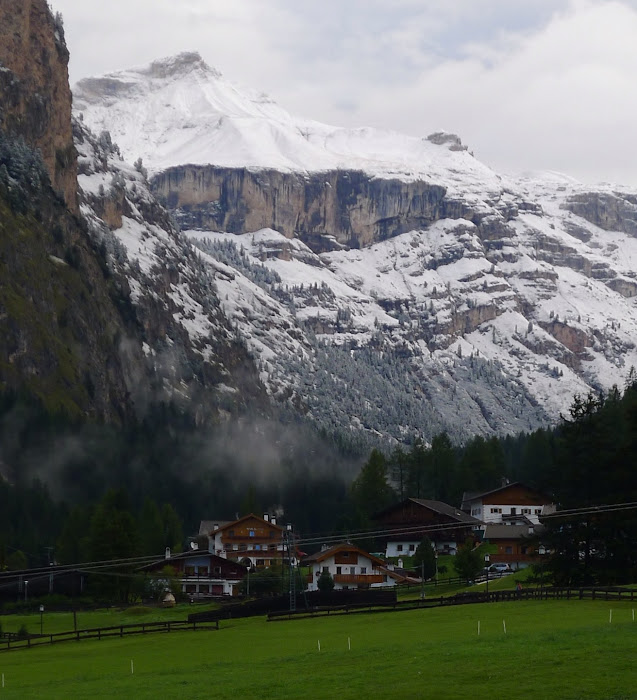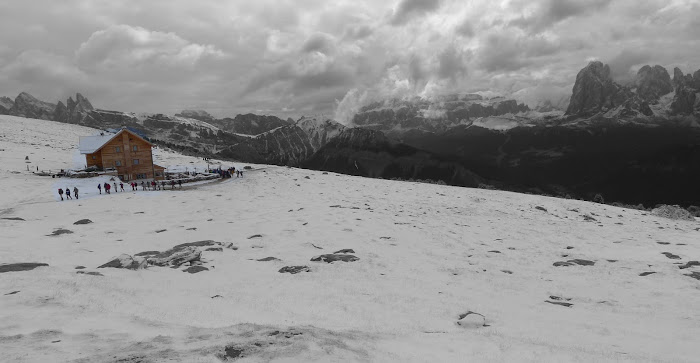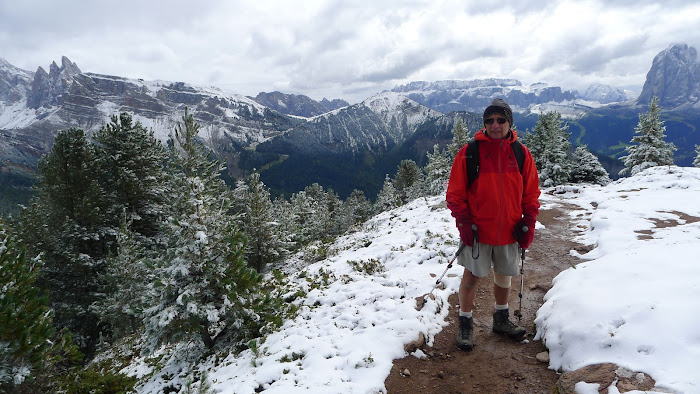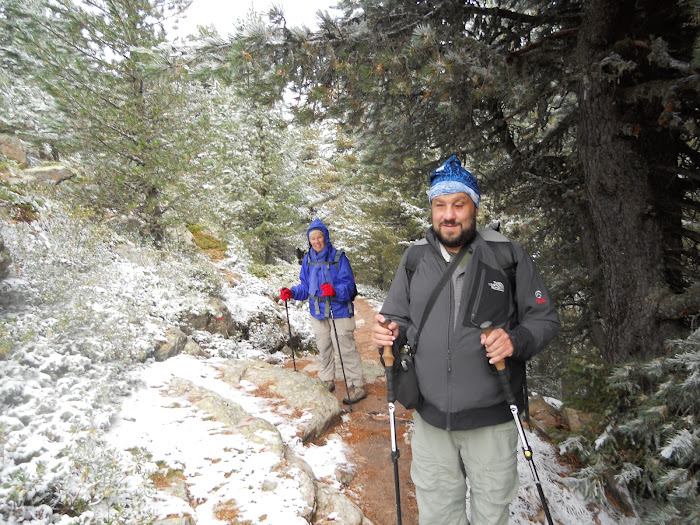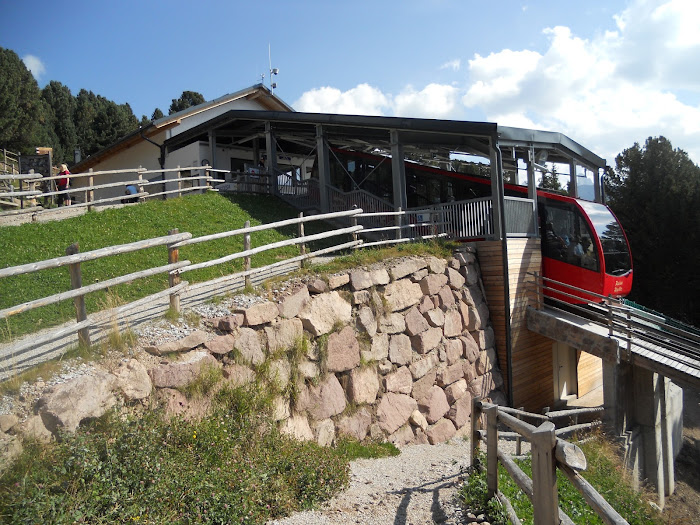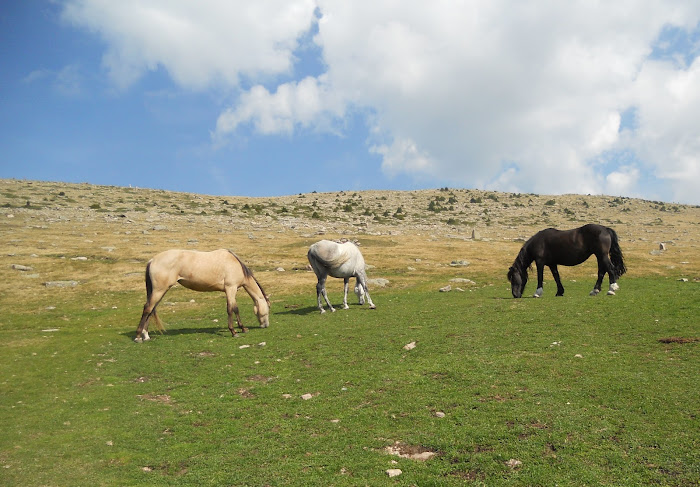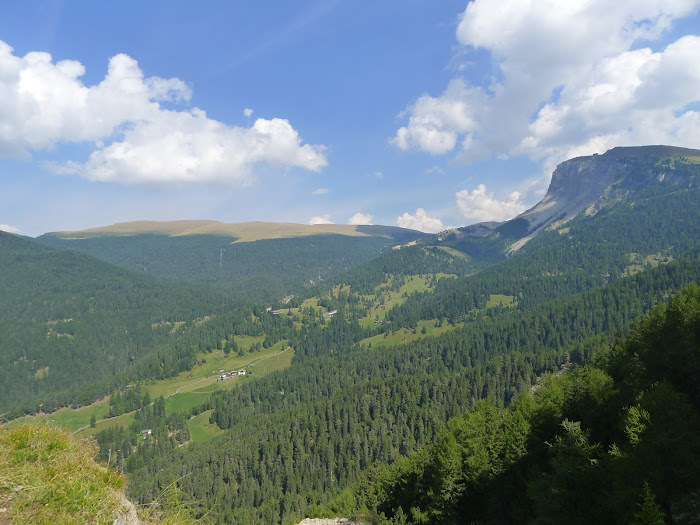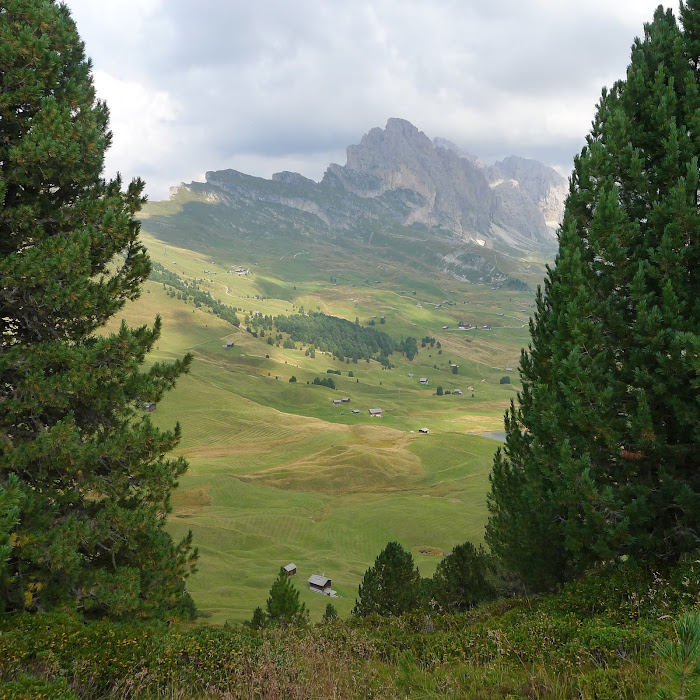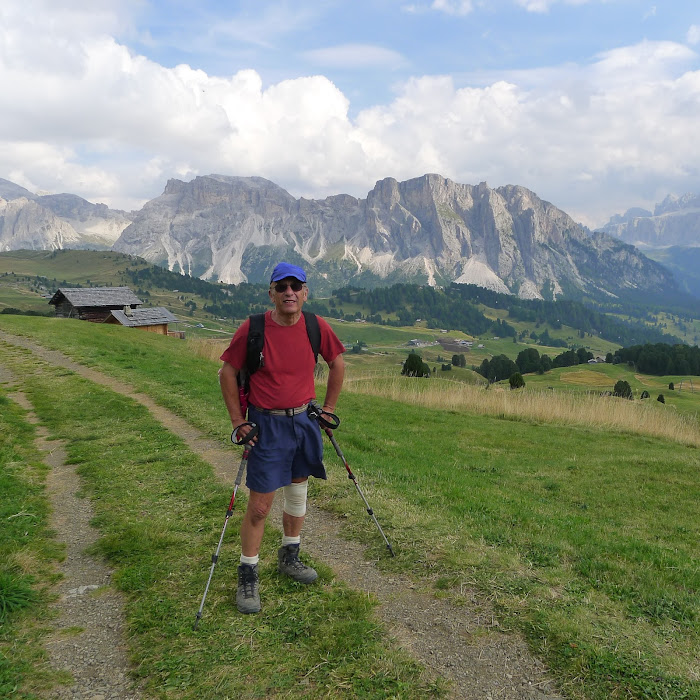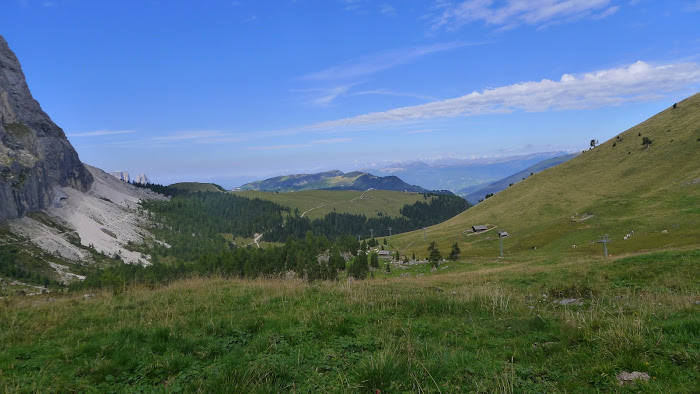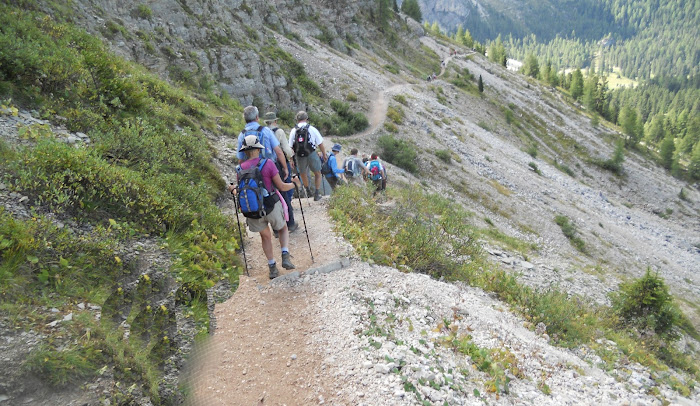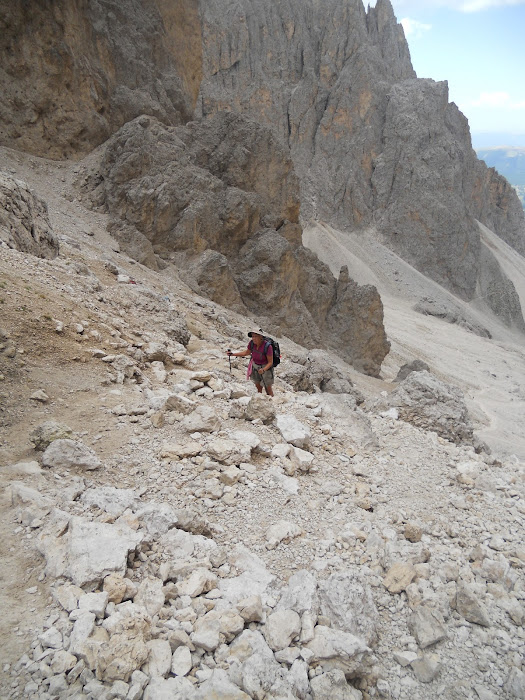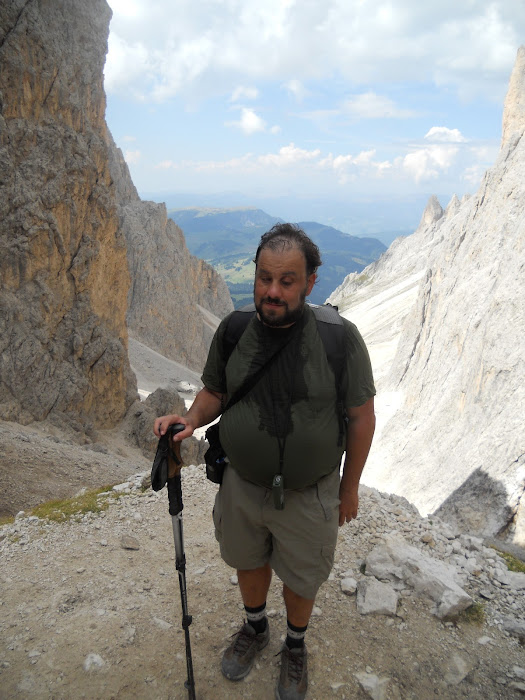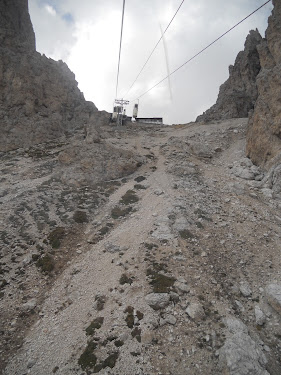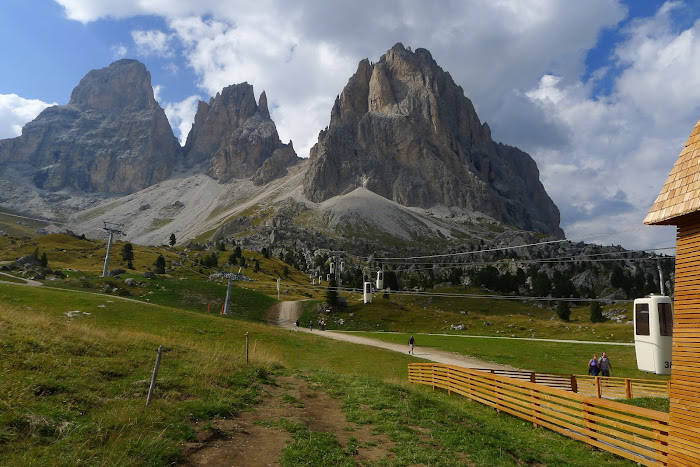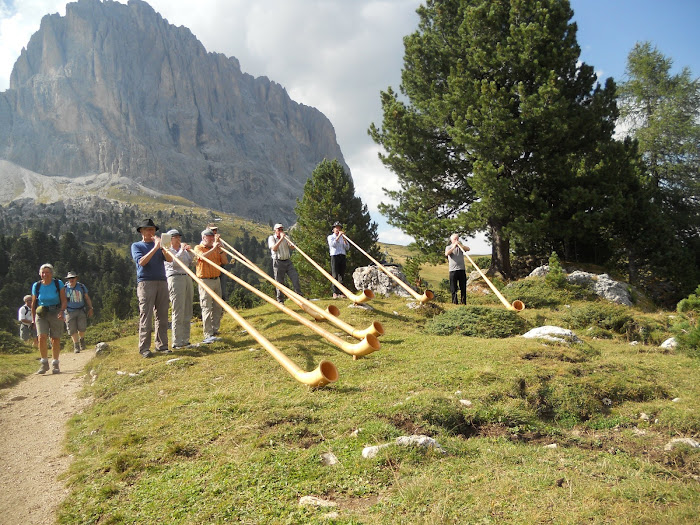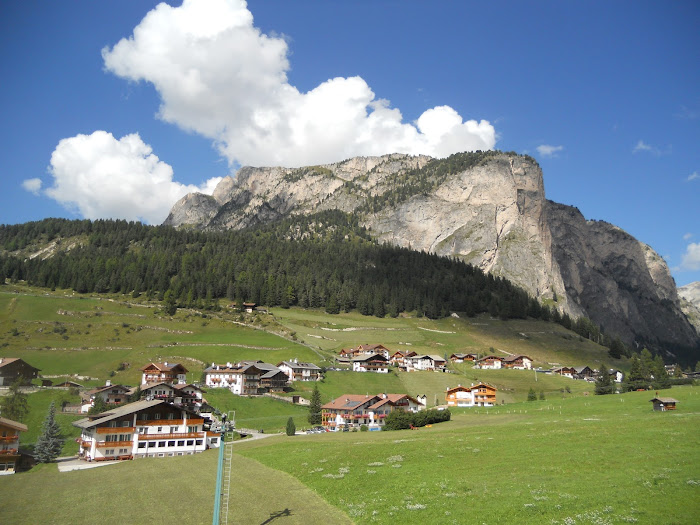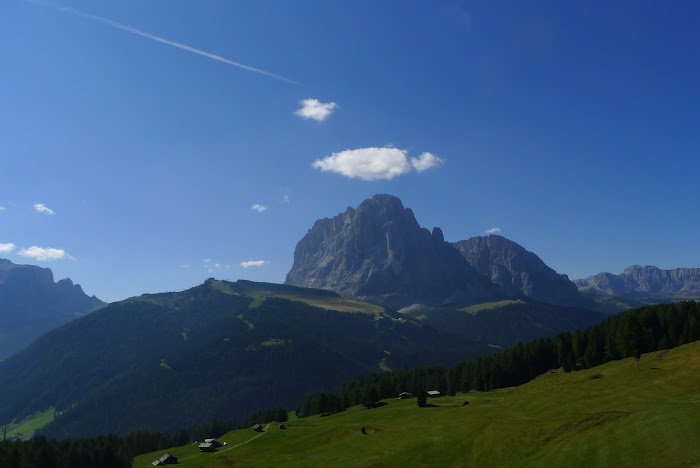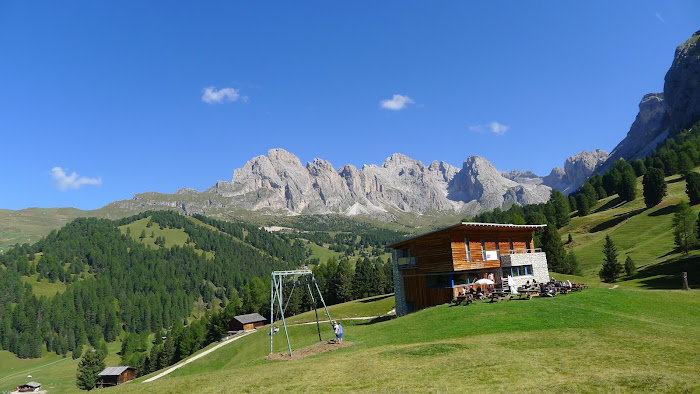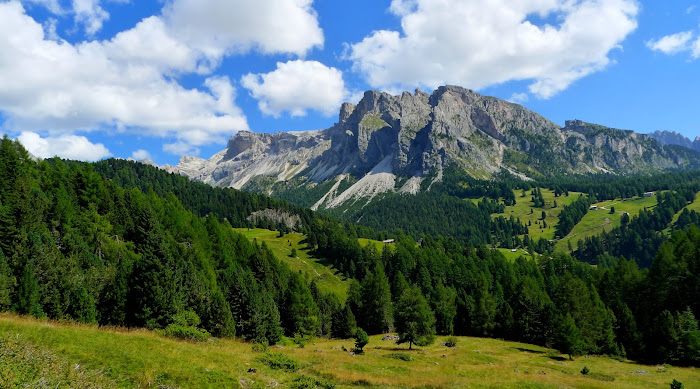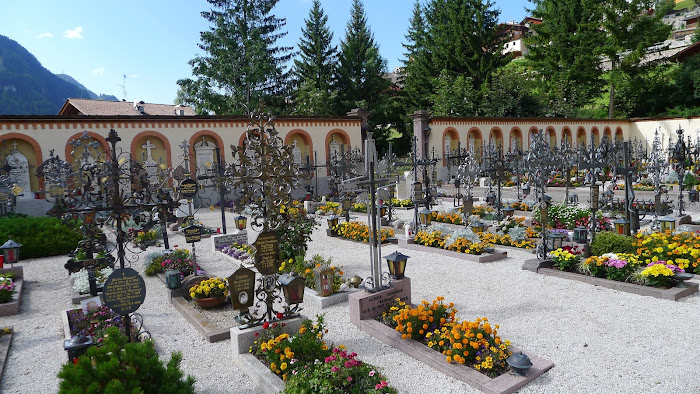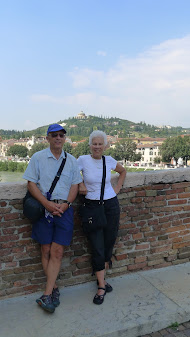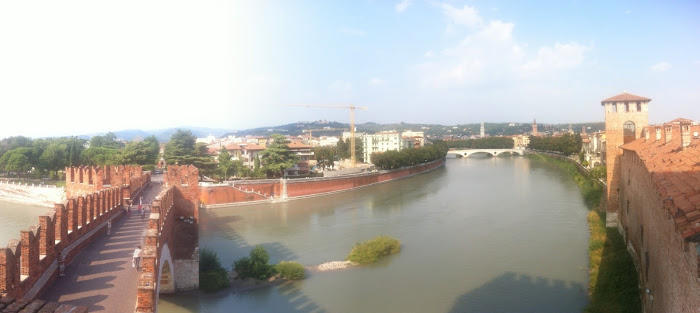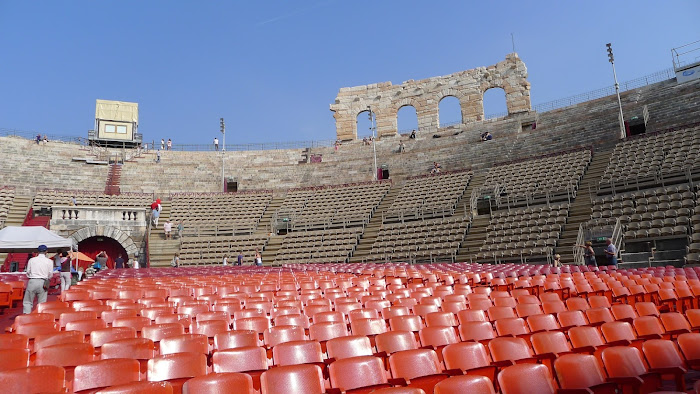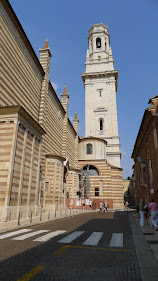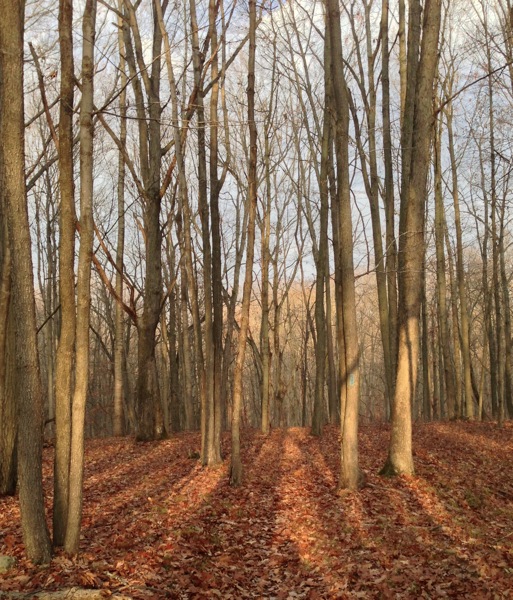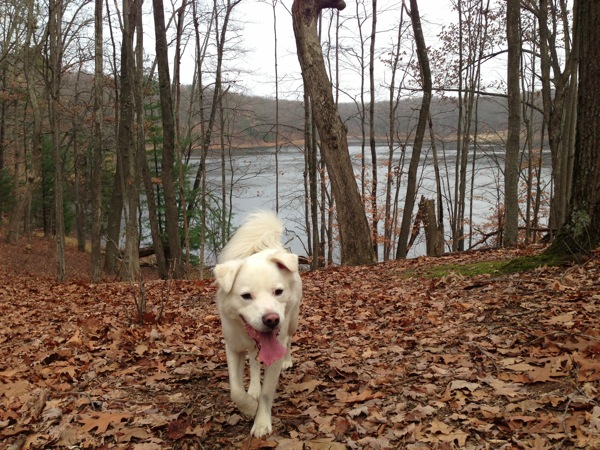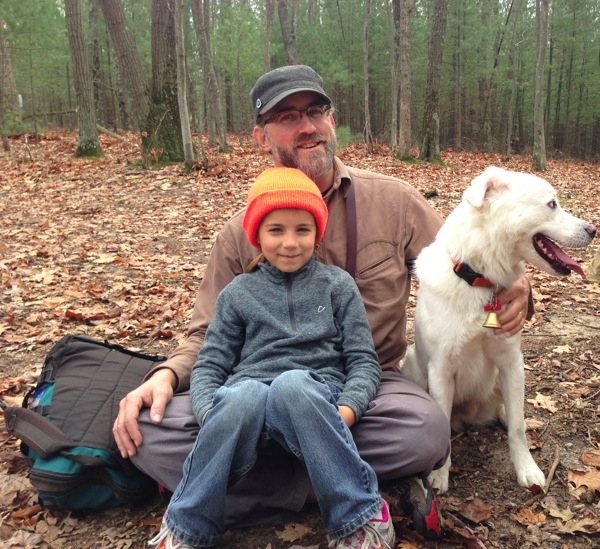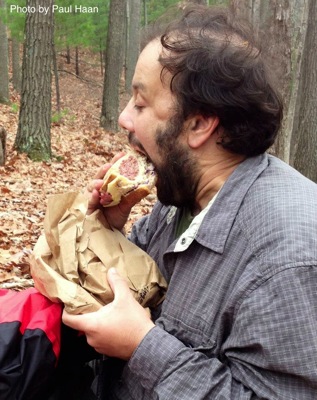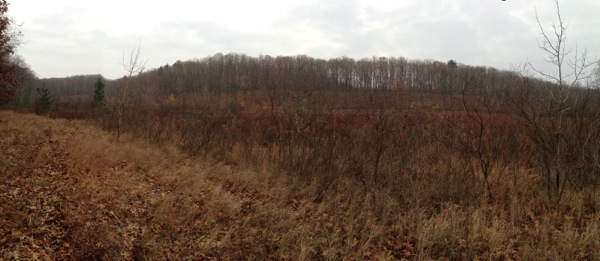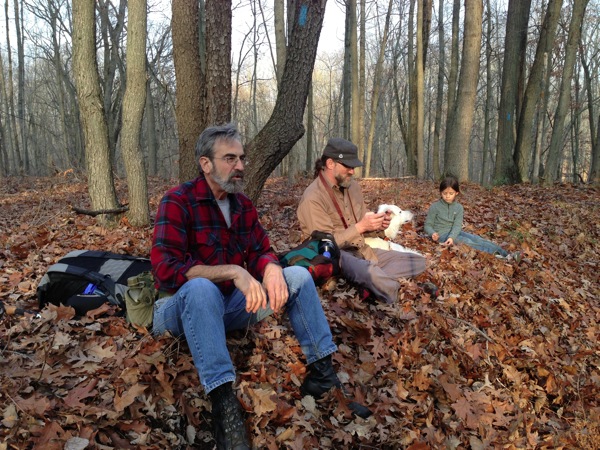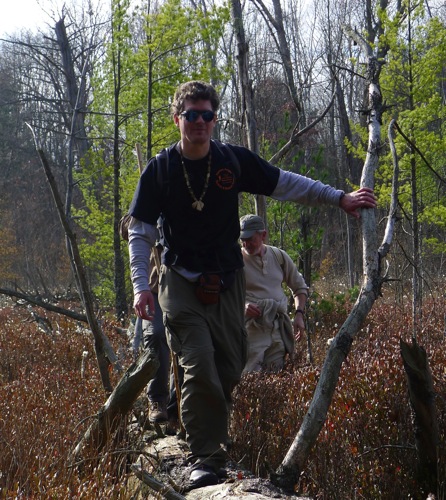We have been in Venice now for 4 days and while I am sure we have only scratched the surface we have seen a lot and formed many opinions. No doubt we have huge gaps in our experiences that will not go away. For example, although we have had dinner as late as 20:00 and sat outside 3 rather different , OK inside one, Venetian restaurants I am certain we still know next to nothing about the nightlife of the city. Personally, I think we have done rather well and it's time to share some of my thoughts in this first blush of Venice type of post.The iconic Venetian Gondalier poling his charges through the seemingly endless canals of Venice.
I strongly suggest, as do guidebooks, taking a water bus (vaporetto) ride during the golden hours around sunrise and sunset. You will have to struggle to get a good viewing spot but if you manage it the rewrd is watching the play of light off the sky, water, and buildings that are anchored by Venice's intricate canal system. Since traffic is slow you have a chance to get good pictures even with a point-and-shoot like I used here (Panasonic Lumix LX5) and elsewhere.
I have come to Venice pretty much cold. I've glanced a little at a guidebook but to say it is cursory is probably being generous. Dad had more detailed ideas in mind of places to visit but nothing really firm. And while my parents visited Venice in 1966 they don't have extensive memories of the visit. Mom recalls that the pigeon population was vast compared to the seemingly small numbers we have seen so far. The waterways seemed dirtier too. We may have preconceived ideas but I think we have been pretty open to whatever we would find. Let's start with our arrival. After a bit of silly confusion with the otherwise fine directions our hotel, the Ca'Pozzo Inn, had provided we got ourselves to the boutique hotel after an easy, though quite crowded, inter-city train ride. When you leave the train station here in Venice prepare for crowds. If what we saw now in mid-September is any indication the throngs must be staggering during high tourist season. Right away we found ourselves confronted with a canal. I am not exactly sure what I was expecting but I am pretty sure finding a light green ribbon of water spanned by arching bridges that rise 3-4 meters above the water right away was not quite it. And though it took a while to register the utter absence of land-based motorized traffic of any sort is also a shock. Perhaps I was imagining dark and dingy black-water canals interspersed with modern streets and sidewalks. That is definitely not what Venice provides. Instead you have canals of green water flowing everywhere. Some, like the Grand Canal, are quite wide but many are just wide enough for boats to park on either side and leave a lane down the middle: think residential street width. The bridges that span the canals probably don't rise more than 3 meters above the waterline and I think, based on the number of steps you ascend, the height is often considerably less than that. Those bridges must be a nightmare for any wheeled vehicle. Some of the larger bridges have shallower steps but I believe we have encountered just two bridges with ramps. If you have to push a stroller you will get a workout hefting it about. How a person in a wheelchair manages is very much unclear. Immediately you start to realize that the way the city works is quite clearly affected by all the canals that weave throughout the metropolis. The streets are best thought of as pedestrian roads. There are some wide boulevards but more often than not you walk down a street of paving stones that is likely wide enough for two people to walk comfortably abreast. There are many narrow alleys to contend with and those alleys are the means of entrance and exit to stores, homes, hotels, and more just as the larger walkways are. If a person wants to get his produce to a market shop he has to offload it from a boat into a human-powered dolly that must be moved across the bridges. If you need trash removed it appears it goes in containers via dollies to be hoisted by winch onto trash boats that haul it somewhere else. Ambulance service is clearly by boat and it must be a wretched time if you need to get someone someplace quickly because you can't go quickly on the canals to say nothing of getting your patient from where she or he is to your boat. If they have to get big machinery somewhere I imagine it is quite a challenge because while a barge can float a lot you have to get that stuff off the boat to where it must go and as I noted earlier land travel is through restricted spaces. Perhaps this forces people to slow down. I am sure it has affected how they build and what they build here. It's remarkable what has been done.
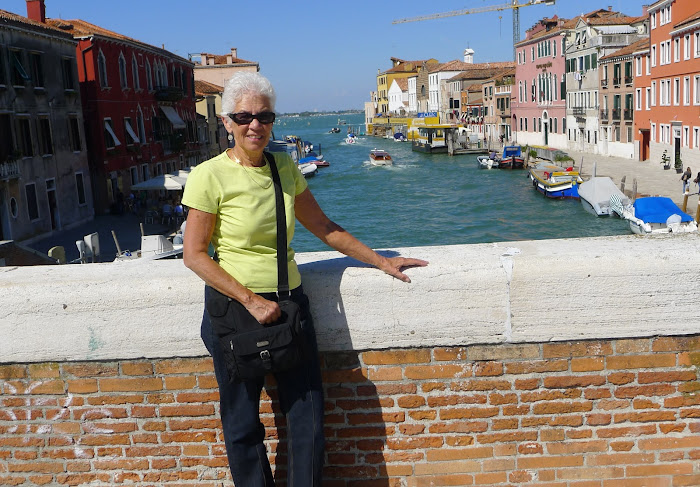 |
| After finding our hotel, the Ca'Pozzo Inn, we started to do some exploration of the neighborhood. First heading northwest to find lunch just beyond this bridge. |
 |
| Looking at a typical single-lane Venetian alley. the alley is getting narrower as it goes (right photo). |
We left to continue strolling about the neighborhood. We were struck by the small streets and numerous canals from the outset. It is a quiet city when you get away from the crowds. The sun glints off the green water from a clear blue sky and you can see why people like the city. It does have a singular lack of living green spaces but it is fun to walk down a narrow alley and pop out into a small square or courtyard and find a quiet place of several buildings including fine shops, hole-in-the-wall bakeries, cafes, and no doubt homes somewhere.
While it is possible to find areas where crowds do not exist don't be fooled into thinking Venice is unpopulated. We slowly worked our way towards San Marco Square (Piazza San Marco) and there we found throngs of people. The throngs were apparent well before the actual plaza and are truly impressive as they form lines to visit the various buildings around the plaza. If the crowds are this big now it is hard to imagine what they must be like during the peak of tourist season. We are very glad to not be here during that time.
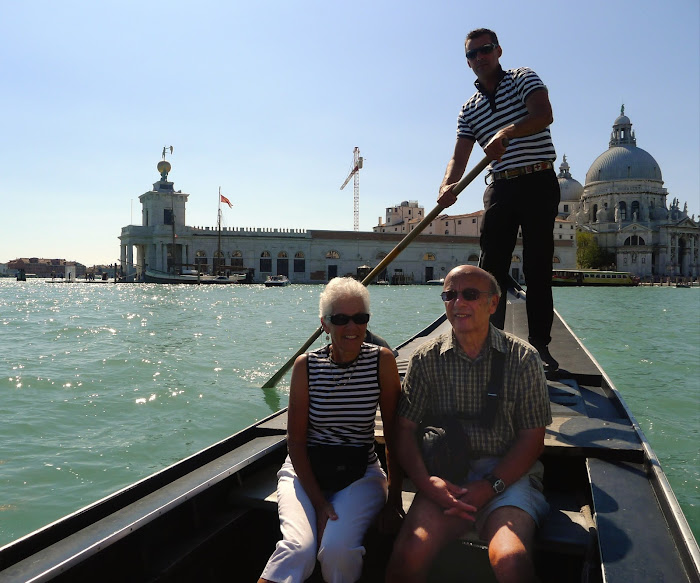 |
| We did take one ride on a Venetian Gondola. The traghetti are guided by two gondoliers (bow and stern) who poll their charges across the Grand Canal. |
The one place in Venice proper we found a few trees though no areas of grass was in the park area that encompasses the Biennale which is, among other things, a huge collection of pavilions and buildings dedicated to various types of art from around the world. I believe it is now a biannual art show for several countries and it has been going for several decades. You can explore a couple dozen buildings from quite modest to fairly large that contain an eclectic range of art from countries including Finland, Spain, Israel, the USA, Venezuela, and more. It is a bit pricey but if you want to soak in a lot of different types of art this is an interesting place to visit. The second part of the whole place is a staggeringly large building that seems wholly dedicated to the exploration of architecture (the Arsenale). It is daunting in its scope but I have a sneaky feeling we will most remember the rather comfortable white plastic cup-like chairs we lounged in for a time when we were done with the visit.
Epilogue
We actually spent the better part of 5 days in Venice. For the bulk of that time we were treated to superb weather. On our last full day we found out what the city could be like when it rains. Our experience was nothing compared to what Venice has just recently experienced with flooding. We joined a former colleague of Mom's for a fancy lunch and during that time a strong rain shower came on through to drench the surroundings. We were under canopies so were pretty well protected. Staff from the restaurant now and then poked the canopy to dump excess water off. Fortunately no one is in a hurry to kick you out from your table so we settled in for a couple of hours while the rain came down. People scampered across the plaza trying to keep dry (umbrellas sales probably shot up) while we ate. It would have been interesting to see how the water in canals reacted to the rain but we weren't near any canals at the time. When the rain abated we left to visit the Peggy Guggenheim Museum the streets were slick but not flooded. I had wondered before what the drainage would be like and it seemed fine.Standing on Ponte de l'Accademia gazing towards the rising sun. This was our cloudiest day in Venice.
I want to take a bit of time to laud the vaporetti. These are the public transportation water buses that get you around the city and associated islands. I strongly suggest that you purchase the multi-day pass instead of buying per trip tickets which end up being considerably more expensive. The boats seem to come in a few different varieties. Whichever style of craft you get on if you can find a place outside, assuming the weather is decent, I think that is preferable. It is far more pleasant to be in the open air and, of course, your view of the cityscape will be far superior. If you are at all interested in photography taking a ride on the Grand Canal during the "golden hours" (just after sunrise and before sunset) is worth it. Try to sit at the bow to have the fewest obstructions to your view. The boats move slowly enough that you can get some rather pleasing pictures. I was surprised that I was even able to do some simple High Dynamic Range (HDR) photography. Finally, I am very glad we decided to take a water taxi to the airport. While you can go to the bus terminal and take an actual wheeled bus to the airport which will be quicker leaving Venice on the water just feels so much more appropriate and the ride is quite enjoyable.
View all the photos from our time in Venice (19 photos).

